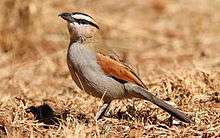Black-crowned tchagra
| Black-crowned tchagra | |
|---|---|
 | |
| Song recorded in Kiboko, Kenya | |
| Scientific classification | |
| Kingdom: | Animalia |
| Phylum: | Chordata |
| Class: | Aves |
| Order: | Passeriformes |
| Family: | Malaconotidae |
| Genus: | Tchagra |
| Species: | T. senegala |
| Binomial name | |
| Tchagra senegala (Linnaeus, 1766) | |

The black-crowned tchagra (Tchagra senegala) is a bushshrike. This family of passerine birds is closely related to the true shrikes in the family Laniidae, and was once included in that group.
This species is found in the Arabian peninsula and most of Africa in scrub, open woodland, semi-desert and cultivation.
Identification
Black-crowned tchagra is a colourful and unmistakable species, 19–22 cm in length. It has a black crown and eye stripes separated by a broad white supercilium. The underparts are pale grey and the upperparts pale brown. The folded wings are chestnut and the tail is black, tipped white. The bill is black.
Sexes are similar, but young birds have a brown cap and a pale yellow bill. There are 14 subspecies, varying in size and the colour of the back, underparts and eyestripe.
Black-crowned tchagra has a descending whistling song, chee-chee chee cheroo cheroo, and can be readily tempted into sight by imitating this call, presumably because the bird is concerned that there is an intruder in its territory. The male also has a switchback display flight.
Behaviour
Black-crowned tchagra lays two or three heavily marked white eggs in a cup nest in a tree or bush. Both sexes, but mainly the female, incubate for 12–15 days to hatching; the chicks fledge after another 15 days.
It is similar in habits to the shrikes, hunting insects and other small prey from a perch in a bush, although it sits less conspicuously than true shrikes.
References
- ↑ BirdLife International (2012). "Tchagra senegalus". IUCN Red List of Threatened Species. Version 2013.2. International Union for Conservation of Nature. Retrieved 26 November 2013.
- Barlow, Wacher and Disley, Birds of The Gambia, ISBN 1-873403-32-1
- Sinclair, Hockey and Tarboton, SASOL Birds of Southern Africa, ISBN 1-86872-721-1
- Tony Harris and Kim Franklin, Shrikes & Bush Shrikes (Christopher Helm, 2000) ISBN 0-691-07036-9
External links
- Black-crowned tchagra - Species text in The Atlas of Southern African Birds.
- Black-crowned tchagra videos, photos & sounds on the Internet Bird Collection
- BirdLife Species Factsheet
